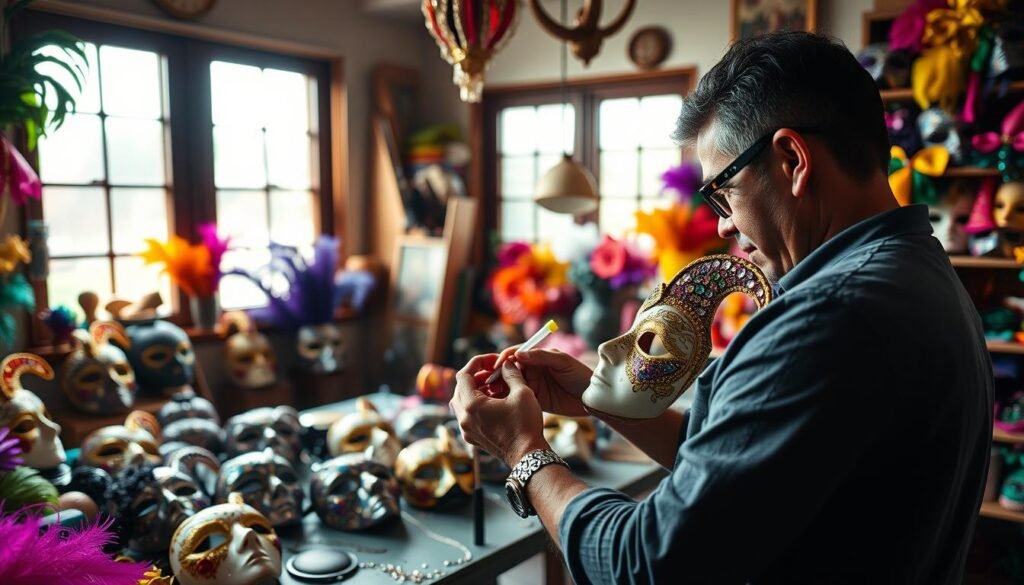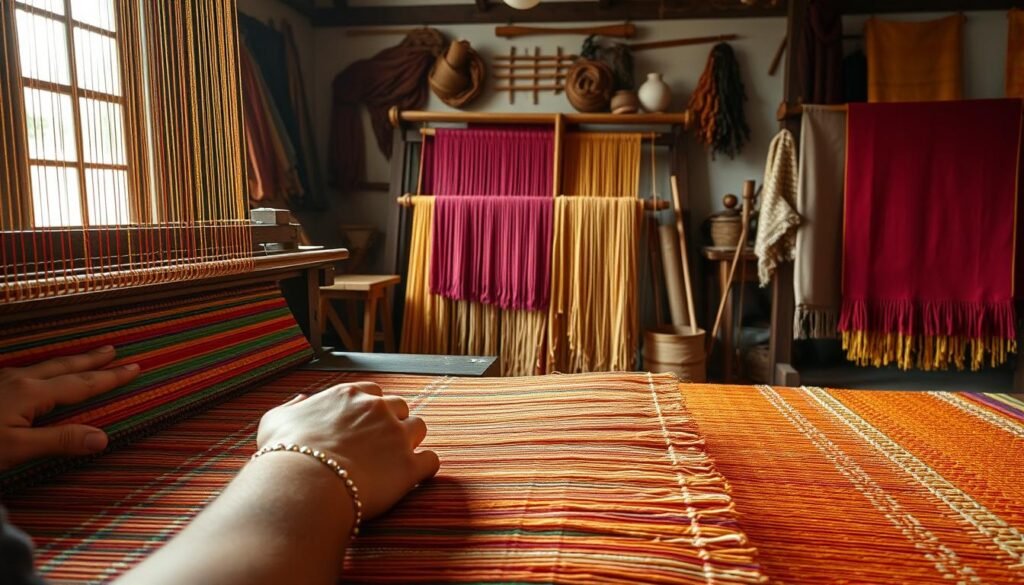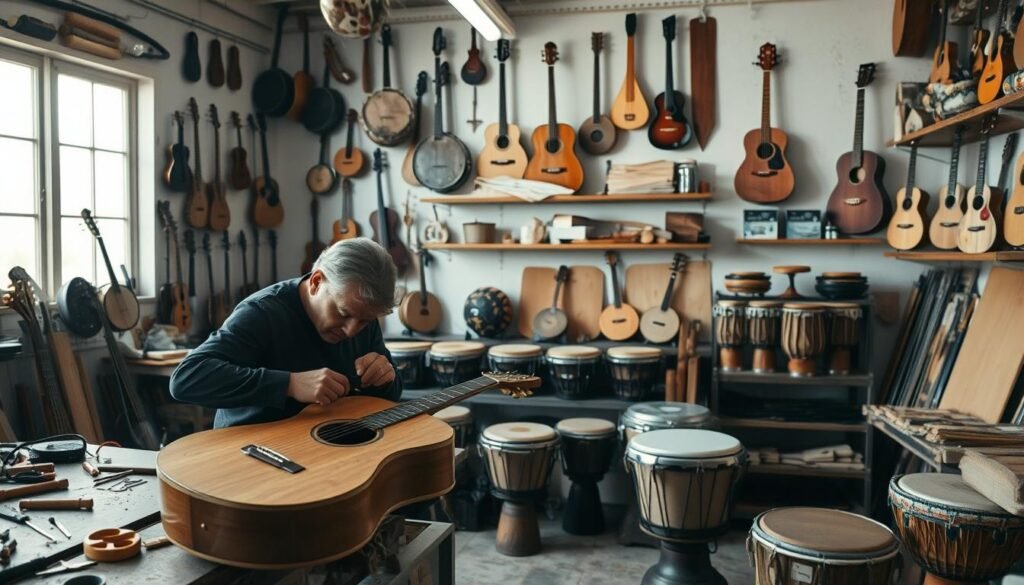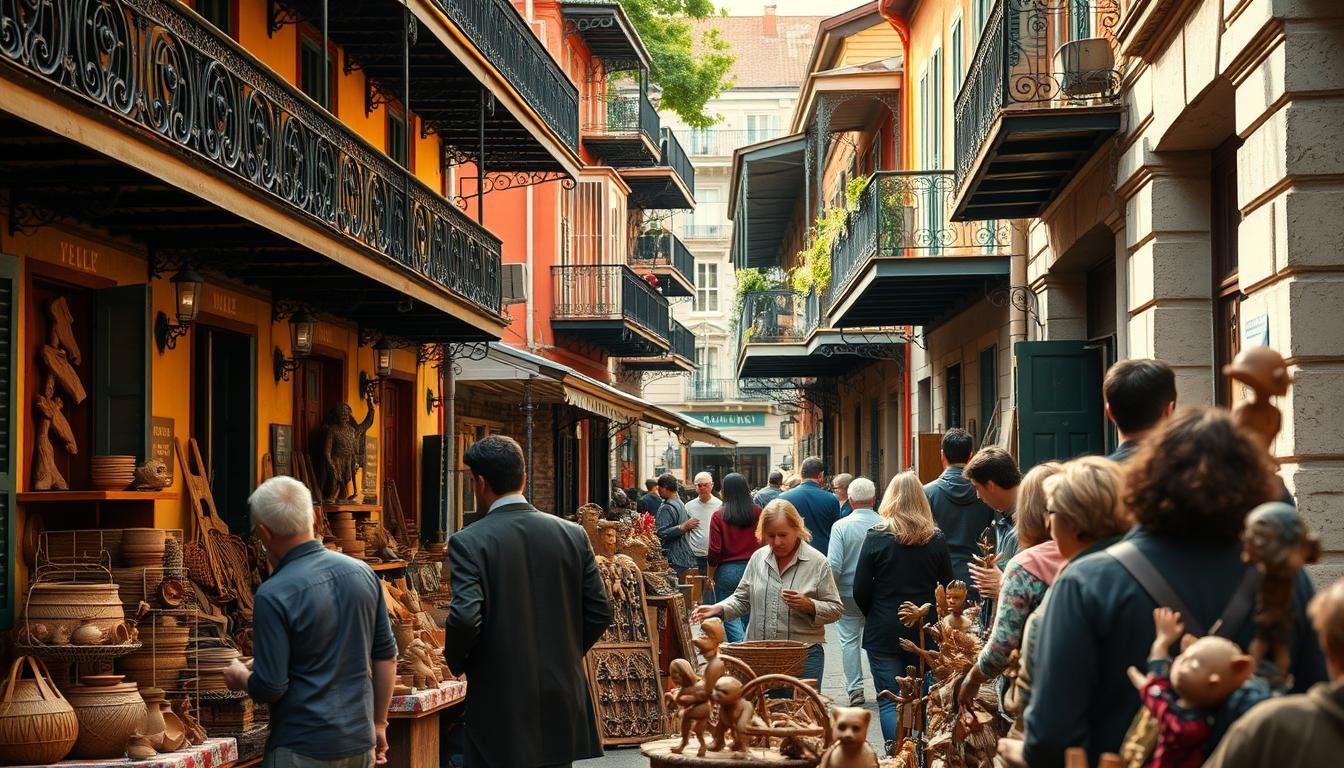Growing up in NOLA, I’ve always been surrounded by the city’s vibrant cultural scene, and one of the most striking aspects is its rich heritage of traditional crafts. From the intricate ironwork to the colorful Mardi Gras masks, these crafts are not just beautiful pieces of art – they’re a window into the city’s history and cultural diversity.
As I explore the city’s folk art traditions, I’m reminded of the many talented artisans who keep these crafts alive. You can find their work in local shops like those listed on albiongould.com, showcasing the best of handmade and craft shops in the city.
Key Takeaways
- Discover the rich cultural heritage of New Orleans through its traditional crafts.
- Explore the city’s folk art traditions and their significance.
- Learn about the talented artisans who keep these crafts alive.
- Find the best handmade and craft shops in New Orleans.
- Experience the city’s vibrant cultural scene firsthand.
Introduction to Traditional Crafts in New Orleans
In New Orleans, traditional crafts are more than just artifacts; they’re a living, breathing embodiment of the city’s history and soul. As you walk through the French Quarter, the sounds of local artisans at work fill the air – from the clang of hammering on metal to the soft scratch of pottery wheels.
What Are Traditional Crafts?
Traditional crafts in New Orleans encompass a wide range of handmade goods, each telling a story of the city’s cultural heritage. These crafts include, but are not limited to, the art of Mardi Gras mask making, pottery, and weaving. Each craft is a testament to the skill and creativity of local artisans who have honed their techniques over generations.
- Mardi Gras mask making, with its intricate designs and vibrant colors, is a hallmark of New Orleans’ festive spirit.
- Pottery, often characterized by its earthy tones and functional designs, reflects the city’s connection to the land and its history.
- Weaving, with its rich textures and patterns, tells stories of the city’s diverse cultural influences.
Significance in New Orleans Culture
These traditional crafts are not just decorative items or souvenirs; they are integral to the fabric of New Orleans culture. They play a significant role in community events, celebrations, and daily life. For instance, Mardi Gras masks are not just worn for fun; they are part of a complex tradition that involves Louisiana crafts and community participation.
The significance of these crafts lies in their ability to connect the past with the present, preserving traditions while allowing for innovation and creativity. They are a source of community pride and a means of cultural expression.
Overview of Craft Styles
New Orleans is renowned for its diverse craft styles, each with its unique characteristics and historical context. From the elaborate Mardi Gras masks to the simple, functional designs of local pottery, each craft style reflects a different aspect of the city’s cultural identity.
Some of the key craft styles include:
- The ornate and colorful Mardi Gras masks, symbolizing the city’s festive and celebratory nature.
- The earthy, functional pottery, highlighting the practical and aesthetic aspects of traditional crafts.
- The intricate weaving, showcasing the city’s rich textile heritage and the stories woven into every fabric.
These craft styles not only beautify the city but also serve as a bridge between the past and the present, keeping traditions alive while fostering creativity and innovation.
The Art of Mardi Gras Mask Making
In the heart of New Orleans, the art of Mardi Gras mask making is a cherished tradition that combines history, creativity, and community spirit. Mardi Gras masks are not just decorative; they are an integral part of the celebration, symbolizing the festive and communal essence of the event.
The history of Mardi Gras masks dates back to ancient European traditions, where masks were used to conceal social classes during carnival season. This practice was brought to America by French and Spanish settlers and evolved into the vibrant tradition seen in New Orleans today.
Ancient Roots and Evolution
Mardi Gras masks have a rich history that spans centuries. Originally, masks were used to allow people to mingle without the constraints of social hierarchy. Over time, the tradition evolved, incorporating local culture and artistic expressions.
Techniques Involved
Crafting Mardi Gras masks involves a variety of techniques, from papier-mâché to intricate hand-painting. Artisans often use a combination of traditional methods and modern materials to create their designs.
- Papier-mâché techniques for durability and texture
- Hand-painting for unique, personalized designs
- Use of feathers, glitter, and other decorative elements
Popular Themes and Designs
Mardi Gras masks come in a wide range of themes and designs, reflecting the diverse cultural influences on the celebration. Common themes include historical figures, mythological creatures, and abstract designs that symbolize the spirit of Mardi Gras.
| Theme | Description | Symbolism |
|---|---|---|
| Historical Figures | Masks depicting famous historical figures, such as kings and queens | Representing the rich history and cultural heritage |
| Mythological Creatures | Masks featuring dragons, phoenixes, and other mythical beings | Embodying the mystical and fantastical elements of Mardi Gras |
| Abstract Designs | Masks with vibrant colors and abstract patterns | Symbolizing the joy and creativity of the celebration |
Mardi Gras mask making is a vibrant art form that continues to evolve, blending tradition with modern creativity. The result is a collection of handcrafted souvenirs and artisanal creations that are cherished by locals and visitors alike.

Pottery: A Timeless Tradition
The art of pottery in New Orleans is a timeless tradition that continues to captivate locals and visitors alike. With its roots deeply embedded in the city’s cultural heritage, pottery has evolved into a unique blend of artistic expression and functionality.
New Orleans pottery is known for its distinctive styles, often reflecting the city’s melting pot culture. The craft has been influenced by various traditions, including African, European, and indigenous American cultures, resulting in a rich tapestry of designs and techniques.
Local Pottery Styles
Local pottery styles in New Orleans are characterized by their vibrant colors, intricate patterns, and a blend of traditional and contemporary designs. Artisans often draw inspiration from the city’s surroundings, incorporating elements of nature and the rich cultural heritage into their work.
From the earthy tones of rustic pottery to the bright hues of modern ceramic art, the diversity in New Orleans pottery is a testament to the city’s creative spirit. Whether it’s a handmade vase, a decorative plate, or a functional item like a mug, each piece of pottery tells a story of the city’s history and its people’s artistic expression.
Key Pottery Artists
New Orleans is home to a number of talented pottery artists who have made significant contributions to the craft. These artisans are not only skilled in their techniques but also dedicated to preserving and promoting the traditional pottery styles of the region.
Some notable artists have gained recognition for their innovative approaches to pottery, blending traditional methods with modern aesthetics. Their work can be found in local galleries, craft fairs, and markets, offering a glimpse into the rich world of New Orleans pottery.
The Role of Pottery in Daily Life
Pottery plays a significant role in daily life in New Orleans, serving both functional and decorative purposes. From kitchenware to decorative pieces that adorn homes, pottery is an integral part of the city’s cultural fabric.
In many local households, handmade pottery items are cherished for their beauty and the personal touch they bring to everyday living. Whether it’s a family heirloom passed down through generations or a contemporary piece acquired from a local artisan, pottery continues to be a meaningful part of New Orleans’ cultural heritage.
The significance of pottery in New Orleans is also reflected in its presence at community gatherings and celebrations. Artisans often showcase their work at local events, where pottery is not only admired for its beauty but also appreciated for its role in bringing people together.
Weaving: Textiles and Storytelling
In the heart of New Orleans, weaving is more than just a craft; it’s a way of storytelling. For generations, local artisans have used weaving to pass down stories, cultural values, and historical events through intricate textile designs.
Weaving techniques in New Orleans are diverse, reflecting the city’s multicultural heritage. Artisans employ traditional methods such as handloom weaving and natural dyeing to create unique textiles that tell stories of the community.
Traditional Techniques
The techniques used in traditional weaving are passed down through generations. Some of the key methods include:
- Handloom weaving, which allows for precise control over patterns and designs.
- Natural dyeing, using plants and minerals to create a range of colors that reflect the local environment.
- Intricate pattern design, often inspired by the city’s rich cultural heritage, including African, European, and indigenous influences.

Community Significance
Weaving plays a vital role in New Orleans community life. It’s not just a form of artistic expression but also a way to preserve cultural heritage and bring people together. Through weaving, artisans share stories of historical events, myths, and legends, keeping the community’s history alive.
The importance of weaving is evident in the way it brings the community together. Local artisans often share their knowledge and skills through workshops and classes, teaching others about the techniques and significance of traditional weaving.
Key aspects of weaving in community life include:
- Preservation of cultural heritage through textile storytelling.
- Community engagement through workshops and classes.
- Celebration of local history and traditions.
By continuing these traditional practices, the community ensures that the stories and cultural values of New Orleans are preserved for future generations.
Music and Crafts: A Creative Fusion
Music isn’t just heard in New Orleans; it’s felt, and that feeling shapes our crafts. The city’s rich musical heritage is a significant influence on the artistry and creativity that goes into crafting handmade instruments and other artisanal creations.
Handmade Instruments
In New Orleans, you can find craftsmen creating instruments that are not just functional but also pieces of art. For instance, handmade guitars and violins are crafted with precision and care, reflecting the city’s jazz legacy. These instruments are often made from locally sourced woods and materials, giving them a unique character.
Some artisans specialize in creating percussion instruments like drums and shakers, using traditional techniques passed down through generations. The process involves selecting the right materials, designing the instrument, and finally, bringing it to life through craftsmanship.

The Influence of Music on Craft Styles
Music’s influence on craft styles in New Orleans is profound. The city’s musical genres, from jazz to zydeco, inspire craftsmen to create pieces that reflect the rhythms and melodies of these styles. For example, the intricate designs on handmade jewelry often mirror the complex rhythms of jazz music.
- Craft styles are influenced by the improvisational nature of jazz.
- Textile patterns may reflect the vibrant energy of Mardi Gras parades.
- Pottery designs often echo the traditional sounds and themes of New Orleans music.
The connection between music and crafts is not just about aesthetics; it’s also about the cultural significance. Crafts become a way to preserve and celebrate the city’s musical heritage, making each handmade piece a testament to New Orleans’ rich cultural identity.
Jewelry Making: Incorporating Local Culture
Jewelry making in New Orleans is not just a craft; it’s a way of storytelling through intricate designs and local materials. This art form has been shaped by the city’s rich cultural heritage, blending influences from various traditions to create something uniquely New Orleans.
Traditional Techniques
The techniques used in traditional New Orleans jewelry making are as diverse as the city’s cultural landscape. Artisans often employ methods passed down through generations, combining them with modern twists to create pieces that are both timeless and contemporary. For instance, filigree work, a technique that involves intricate threading of metal, is commonly used to add delicate details to jewelry pieces.
Key Techniques Include:
- Filigree work for detailed metalwork
- Beadwork, incorporating local beads and materials
- Metal smithing, using techniques like hammering and shaping
Local Materials Used
One of the defining characteristics of New Orleans jewelry making is the use of local materials. Artisans often incorporate elements found in the city and its surroundings, such as cypress wood, Spanish moss, and gemstones from regional mines. These materials not only add a local flavor to the jewelry but also tell a story of the region’s natural beauty and history.

The Symbolism Behind Designs
The designs in New Orleans jewelry are often imbued with symbolism, reflecting the city’s cultural and spiritual heritage. For example, the use of the evil eye symbol is believed to ward off bad luck, while florals and foliage patterns may represent growth and abundance. Each piece of jewelry is a narrative, weaving together the artisan’s interpretation of New Orleans’ vibrant culture.
| Symbol | Meaning |
|---|---|
| Evil Eye | Protection against bad luck |
| Florals/Foliage | Representing growth and abundance |
| Crescent Moon | Symbolizing change and intuition |
By understanding the techniques, materials, and symbolism behind New Orleans jewelry making, we gain a deeper appreciation for this craft as a vital part of the city’s cultural identity. Whether you’re a local or just visiting, wearing a piece of New Orleans jewelry is a way to connect with the city’s rich heritage.
Culinary Crafts: A Taste of New Orleans
New Orleans is renowned for its culinary delights, a blend of French, Spanish, African, and Caribbean flavors. This rich cultural tapestry is reflected in the city’s culinary crafts, where food is treated as an art form.
Food as an Art Form
In New Orleans, culinary crafts are not just about sustenance; they’re an expression of the city’s history and culture. Creole cuisine, for instance, is a unique blend of flavors and techniques passed down through generations. Local chefs and artisans take pride in their work, using traditional methods to create dishes that are both delicious and visually appealing.
Specialty Foods and Craftsmanship
New Orleans is famous for its specialty foods, such as beignets, gumbo, and jambalaya. These dishes are crafted with care and attention to detail, using locally sourced ingredients whenever possible. The craftsmanship that goes into creating these culinary delights is a testament to the city’s rich cultural heritage.
| Specialty Food | Description | Key Ingredients |
|---|---|---|
| Beignets | Fried dough pastries covered in powdered sugar | Flour, sugar, yeast |
| Gumbo | A hearty stew made with a combination of ingredients | Okra, rice, and a variety of meats and seafood |
| Jambalaya | A one-pot dish made with sausage, rice, and a mix of vegetables and meats | Sausage, rice, tomatoes |
Celebrating Local Ingredients
The use of local ingredients is a key aspect of New Orleans culinary crafts. By incorporating fresh produce, meats, and seafood from local farms and suppliers, chefs and artisans are able to create dishes that are not only delicious but also reflective of the region’s unique flavors.
Local ingredients such as Creole tomatoes and Andouille sausage add depth and authenticity to traditional New Orleans dishes. The emphasis on local ingredients also supports the local economy and helps to preserve the city’s culinary traditions.
Craft Fairs and Markets in New Orleans
Craft fairs and markets are an integral part of New Orleans’ cultural landscape, showcasing the city’s unique artisanal talents. As a local, I’ve had the pleasure of attending these events numerous times, and each experience is a testament to the city’s vibrant creative spirit.
When visiting New Orleans, there’s no better way to immerse yourself in the local culture than by attending one of the many craft fairs and markets. These events are a treasure trove of handmade crafts, from intricate masks to beautifully woven textiles, all crafted with love and care by local artisans.
Major Craft Events to Attend
New Orleans hosts a variety of craft fairs and markets throughout the year, each with its own unique charm. Some of the most popular events include the New Orleans Jazz & Heritage Festival, where you can find everything from handmade jewelry to artisanal foods. Another must-visit is the Crescent City Farmers Market, which showcases local produce, crafts, and prepared foods.
- The New Orleans Arts and Crafts Market
- The French Quarter Festival
- The Voodoo Fest
These events are not just about shopping; they’re about experiencing the city’s culture firsthand. You can watch artisans at work, learn about their techniques, and even participate in workshops to try your hand at crafting your own unique piece.
The Importance of Community Engagement
Community engagement is at the heart of New Orleans’ craft fairs and markets. These events bring people together, fostering a sense of community and connection among locals and visitors alike. By supporting local artisans, you’re not only taking home a piece of the city’s culture, but you’re also contributing to the local economy and helping to preserve traditional crafts.
As someone who’s attended these events numerous times, I can attest to the joy of connecting with the artisans and learning about their crafts. It’s a truly enriching experience that leaves you with a deeper appreciation for the city’s cultural heritage.
In conclusion, New Orleans’ craft fairs and markets are a must-visit for anyone looking to experience the city’s unique cultural landscape. So, come on down, meet the artisans, and take home a piece of New Orleans – you’ll be supporting the local community and creating memories that will last a lifetime.
Preserving and Promoting Traditional Crafts
New Orleans’ traditional crafts are a vibrant part of the city’s heritage, and preserving them is crucial for maintaining the community’s cultural identity. As a local, I’ve seen firsthand the impact that supporting local artisans can have on our community.
Learning Opportunities
For those interested in learning traditional crafts, there are various education and workshops available. Organizations like the New Orleans Arts Council offer classes in crafts such as pottery, weaving, and jewelry making. These workshops not only teach techniques but also provide a platform for artisans to share their stories and experiences.
Supporting Local Artisans
To support local artisans, consider visiting craft fairs and markets, where you can see artisans at work and purchase handmade items. You can also promote their work by sharing it on social media or recommending it to friends. By supporting local artisans, you’re helping to preserve the traditional crafts that make New Orleans so unique.
FAQ
What are the traditional crafts of New Orleans?
New Orleans is known for its vibrant cultural scene, reflected in traditional crafts such as Mardi Gras mask making, pottery, weaving, jewelry making, and culinary crafts. These crafts are a vital part of the city’s identity, reflecting its history and cultural diversity.
How can I learn about traditional New Orleans crafts?
You can learn about traditional New Orleans crafts by attending local craft fairs and markets, visiting artisan workshops, and taking classes or workshops that focus on specific crafts like Mardi Gras mask making or pottery.
What is the significance of Mardi Gras masks in New Orleans culture?
Mardi Gras masks have a long history, dating back to ancient European traditions. In New Orleans, they are an integral part of the Mardi Gras experience, symbolizing the spirit of celebration and community. The masks are not just decorative but also carry significant cultural meaning.
How does pottery reflect the cultural heritage of New Orleans?
New Orleans pottery is known for its unique styles, often reflecting the city’s cultural melting pot. The craft is not just decorative but also functional, playing a significant role in daily life. Local pottery styles and artists contribute to the rich cultural tapestry of the city.
What role does weaving play in New Orleans community life?
Weaving is a traditional craft that tells stories and passes down cultural heritage. In New Orleans, it brings people together and preserves cultural stories. The craft is significant in community life, reflecting the city’s rich cultural identity.
How can I support local artisans in New Orleans?
You can support local artisans by attending craft fairs and markets, purchasing handmade goods, and participating in workshops or classes that promote traditional crafts. Supporting local artisans ensures the continuation of these valuable traditions.
What is the connection between music and crafts in New Orleans?
Music plays a crucial role in New Orleans culture, influencing various art forms, including crafts. Handmade instruments and craft styles are often inspired by the city’s rich musical heritage, creating a unique cultural identity that’s both vibrant and soulful.
How does jewelry making reflect New Orleans culture?
Jewelry making in New Orleans incorporates local materials and cultural symbols, reflecting the city’s cultural heritage. The craft is not just decorative but also tells stories and preserves cultural identity.
What makes New Orleans cuisine unique?
New Orleans cuisine is a blend of various cultural influences, making it unique and flavorful. The city’s culinary crafts treat food as an art form, celebrating local ingredients and the craftsmanship that goes into creating specialty foods.
How can I experience the best of New Orleans traditional crafts?
To experience the best of New Orleans traditional crafts, attend local craft fairs and markets, visit artisan workshops, and take classes or workshops that focus on specific crafts. This will give you a deeper understanding and appreciation of the city’s rich cultural heritage.
